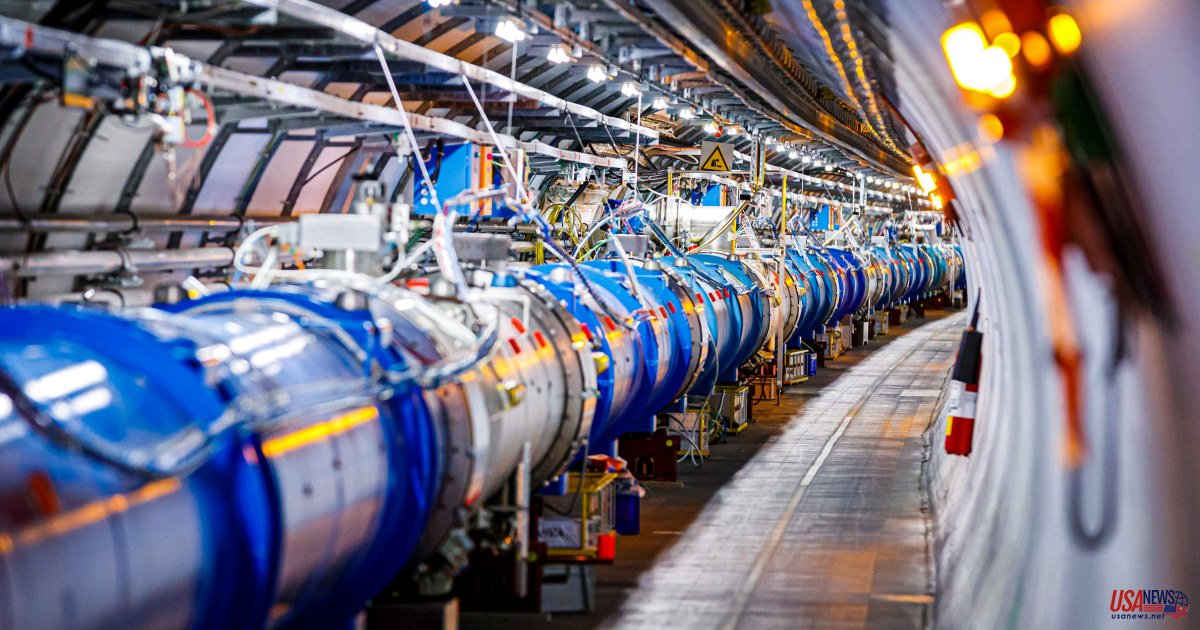Faster, better, stronger.
In a few weeks, a new phase of operations at Large Hadron Collider -- which is the largest particle accelerator in the world -- will begin. This comes just one day after the 10th anniversary its most significant achievement: the discovery and subsequent declassification of the Higgs boson.
Reopening the collider (which has been closed since 2018) will be a significant event in global science. This is because what is widely considered to be one of the most important science experiments ever performed has already revealed important details about reality's fabric.
In July 2012, the Higgs discovery confirmed the Standard Model of Particle Physics. This model still remains the most accurate explanation of the workings of matter. Scientists hope that the LHC's latest run will reveal even more mysteries about existence, including the invisible particles making up dark matter and why there is any.
Rende Steerenberg is the head of beam operations at CERN, an international organization that manages the LHC. He said, "We're now prepared for Run 3".
The LHC was dormant for over three years, while it was being upgraded with tens to millions of dollars worth improvements. It will now achieve energies up to 13.6 trillion electronvolts (TeV) -- compared to only 13 TeV in its previous run -- and advanced equipment to better analyze the chaotic explosions within the gigantic atom smasher. The LHC is currently being tested at low power, and the first experimental collisions for the third run will be held on July 5.
The LHC uses huge magnets to accelerate protons and nuclei in opposite directions within the underground ring. They then combine them for high-energy collisions at the speed of light. The LHC can achieve energies not seen since the Big Bang.
Scientists can learn which particles were formed by studying the remains of these collisions, even if they are only for a fraction of a second. Scientists believe that at least some of these exotic particles will be produced by the LHC's thousands of collisions every hour.
Steerenberg explained that the LHC's most recent upgrade is only half of what will be required before more detecting methods can be installed after 2027. The LHC will then operate at its full capacity as the "High Luminosity LHC" -- the fourth and last version before an even bigger particle accelerator, Future Circular Collider comes online after 2040.
The LHC is an important tool for physicists. There are still many unsolved issues in theories that attempt to explain physical reality. Some of these problems date back to the early 20th Century. Scientists have offered a range of solutions. While some of these ideas are possible on paper, they require certain particles to be present with specific qualities.
The LHC is the world's most powerful particle accelerator. It was built to search for and measure those particles. These results are integrated into the Standard Model which describes all known particles (currently 31 including the Higgs boson), and three of the four fundamental forces, the electromagnetic force, strong nuclear force, and weak nuclear force. However, it does not include gravity.
Scientists believe that the upgraded LHC will allow for more precise measurements of all the particles that make up the matter we see. It also may help to resolve some anomalies in the Standard Model, which have been recently reported.
One of the most surprising is the discrepancy observed in the decay of B-meson. This transient particle, composed of two types quarks -- subatomic particles that make up neutrons and protons -- is one of the most puzzlesome.
The theory holds that B-mesons should eventually decay into electrons or muons, which are related subatomic particles with an equal rarity. However, experiments have shown that B-mesons are more likely to decay into electrons than into muons according to Chris Parkes (particle physicist), who is the leader of the Large Hadron Collider Beauty experiment.
LHCb is named after the "beauty” quark, which features prominently during the experiment's investigation of the differences between matter & antimatter. Quarks can also classified as "truth", "up," or "down," depending on their characteristics.
In the initial moments of the Big Bang, antimatter and matter should have been equal. But that didn't happen. Instead, matter dominates and the LHCb experiment will attempt to discover why.
Parkes stated that the reported anomaly in B-meson decay could be related to this question and that the new run at the LHC might provide insight into why it is occurring.
He said, "There are many different measurements, and quite a few of them point in the same direction." "But there's no smoking gun -- it's an interesting picture that's been captured over the past few years."
A second anomaly to note is the mass of W-boson. This subatomic particle is involved in the weak nuclear force action that governs certain types of radioactivity.
According to the Standard Model, W-bosons are predicted to have a mass around 80,357 millions electron volts. This number has been confirmed in several particle accelerator experiments.
However, a series of experiments at Fermilab's Tevatron particle accelerator near Chicago suggests that the W-boson is weighing a bit more than it should. This could indicate that "new physics" may be possible beyond the Standard Model.
Ashutosh Kotwal is a particle physicist at Duke University in Durham, North Carolina. He led the Fermilab research that revealed the discrepancy. However, there has been no evidence to support this theory.
Kotwal is also a researcher in the LHC and hopes that its upgraded run can prove that supersymmetry is not just an idea. He said that it was possible that the Wboson senses the existence supersymmetric particles.
If supersymmetry turns out to be a principle in the universe, it may help explain other mysteries such as the nature and origin of ghostly "dark material" particles. Many physicists believe that they make up about three-quarters all of the matter in our universe.
The structure of galaxies is explained by the gravity from dark matter particles, but the particles themselves are not visible and physicists have yet to discover what they could be.













